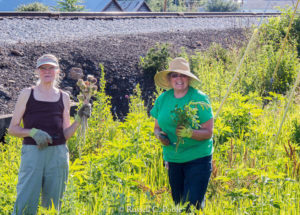Christine Schoene Maccabee
Wildflowers Along the Railraod Track
Anyone who has driven or walked or jogged or biked along Woodside Drive in Thurmont this spring will have noticed the colorful flowers along the railroad track. Many of these flowers are various poppies, mallows, and cornflowers from a mix of flower seeds spread over a few areas prepared in early spring. Miraculously, many of these seeds sprouted and grew in spite of a very dry period, with no one watering them.
Much to the relief of most neighbors on Woodside Drive, a deal was made with the Midland Railroad company not to spray herbicides along the tracks in that area. One fellow said he would rather see green and growing things than dead and dying things, not to mention the toxic smell that wafted over to his property. This project has been just one of the many things the Green Team of Thurmont has been doing for about one year now. You may have already read about these efforts to create a more sustainable, green community. The Green Team is flourishing and, of course, always welcomes new enthusiasts. This wildflower project is just one of many great projects, such as energy saving in homes and businesses, encouraging citizens to shop locally, watershed stewardship, the farmers market, community vegetable gardens, and so on.
Much like any creative project, this garden along the railroad tracks is just getting started, and it will take a few years to rid it of invasives and “unwanteds,” as I call them. However, as the ladies helping to implement this vision know, there are already many important wildflowers growing there that came directly from the soil, no seeding or planting necessary. Some of these flowers are late bloomers, such as the wild asters and evening primroses, so keep your eyes peeled for a late summer show.
Right now, the Queen Ann’s Lace are showing off with all their summer splendor, even as the spring poppies are fading away. Those lovely poppies will return next spring, however, with even more numbers, as thousands of seeds from their seed capsules will drop and fly wherever the wind may blow. That is the beauty of a wild area: It eventually will self-sow.
We have plans this autumn to prepare other areas for sowing of wild native plant seeds, such as coneflowers, black-eyed Susans, lupines, and many more. We will also do some live plantings. Until then, through this summer heat, you may see a couple of us at a time, sweating as we are “working on the railroad,” cutting back lambs quarters, thistle, and wild lettuce before they go to seed. We are projecting that this project, though on-going for years, will be greatly enhanced within about three years. Of course, we welcome any other hardy volunteers to help, so please call or write us (see contact information at the end of this article).
Now, I know that not all people like such a wild display. However, I also know for a fact that the members of the wild community love and need it. If one stands long enough to observe, one will see bees, maybe butterflies, and the birds, which are eating both seeds and bugs. These insects and birds will travel to front and backyard gardens to delight the owners; therein is the secret to creating a natural community of which humans can be an important member.
The more habitat for wild plants and wildlife, the better, as far as most experts are concerned. Air quality improves, streams are cleaner and cooler for aquatic life, bees have more nectar and pollen for survival—and for us to put honey on our toast—and our children will learn more about the importance of connecting with the natural world and how humans can be such an important part of this amazing wild world, if only to protect and enhance it.
If you wish to join with us in the Green Team, please contact us at thurmontgreenteam@gmail.com. You can also write Jim Humerick at the town office at JHumerick@thurmontstaff.com, or you can write me at songbirdschant@gmail.com.

Christine and Cindy Poole at the railroad tracks for the wildflower project, just one of the many wonderful projects the Green Team has in the works.

